This unit begins with an activity to model the “I notice” method with Ezra Pound’s “In a Station of the Metro”. For the second activity, teachers should select contemporary poems that allow for a variety of the four levels of Poetry to be thoroughly noticed. Attached is a student sample Poem Level Meter for “Let Evening Come” by Jane Kenyon, and three other poems from the Academy of American Poets are suggested. However, any poem from the Academy of American Poets website could be used effectively to teach this reading method.
By the time students have arrived in high school, they may have had some good experiences with poetry, but many may still be unsure of what poetry is or how to immerse themselves in its language. This method helps students, particularly those in grades nine and ten, return to an immersion in the language itself, which is essential to being able to read, experience, and appreciate poetry for what it is—language art.
Essential to this lesson is the idea that by focusing on the levels in poetry and initially noticing the amount of language levels, students can experience Poetry without focusing directly on what poems mean, eventually organically arriving at meaning–making on their own. This helps students avoid, as Billy Collins wrote in his “Introduction to Poetry”, “beating [the poem] with a hose/ to find out what it really means” and provides students with an authentic, mindful way of immersing themselves in the language. This method also prepares students for writing about their ideas informally or formally in later assignments.
To the teacher: Please familiarize yourself with the link on the blog, the PowerPoint introduction, the language level cards, the Poem Level Meter, and the Student Progress Tracker handouts prior to engaging in this lesson with students.
Reading Literature:
CCSS.ELA-Literacy.RL, Key Ideas & Details, 9-10.1
CCSS.ELA-Literacy.RL, Key Ideas & Details, 9-10.2
CCSS.ELA-LITERACY.RL, Craft and Structure, 9-10.4
CCSS.ELA-LITERACY.RL, Craft and Structure, 9-10.5
CCSS.ELA-Literacy.RL, Range of Reading and Level of Text Complexity, 9-10.10
Speaking and Listening:
CCSS. ELA-Literacy.SL, Comprehension and Collaboration, 9-12.1
Objective: Students will learn how to notice the four levels inherent in the poem, “In a Station of the Metro” by Ezra Pound.
Note: First, introduce students to the noticing method through the “Letter to Students Before We Start to Read Poems” and its corresponding PowerPoint on the S. A. Slaby Blog.
Next, give students a hard copy of the poem “In a Station of the Metro” by Ezra Pound.
- Give students packets of the four cards below or direct them to the website to view the cards. These four cards are reminders of the four levels of Poetry, adapted from Lewis Turco’s The Book of Forms: A Handbook of Poetics, Including Odd and Invented Forms and Michael Theune’s Structure & Surprise: Engaging Poetic Turns.
- Here are the cards:
1.
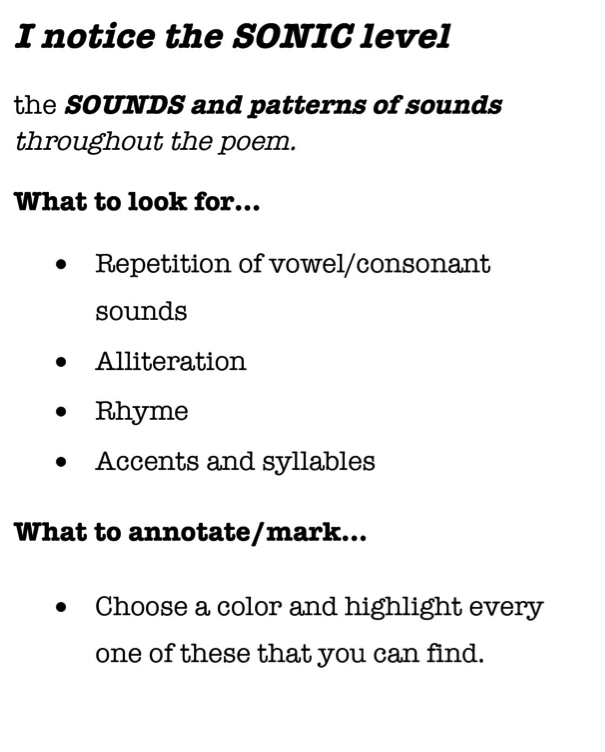
2.
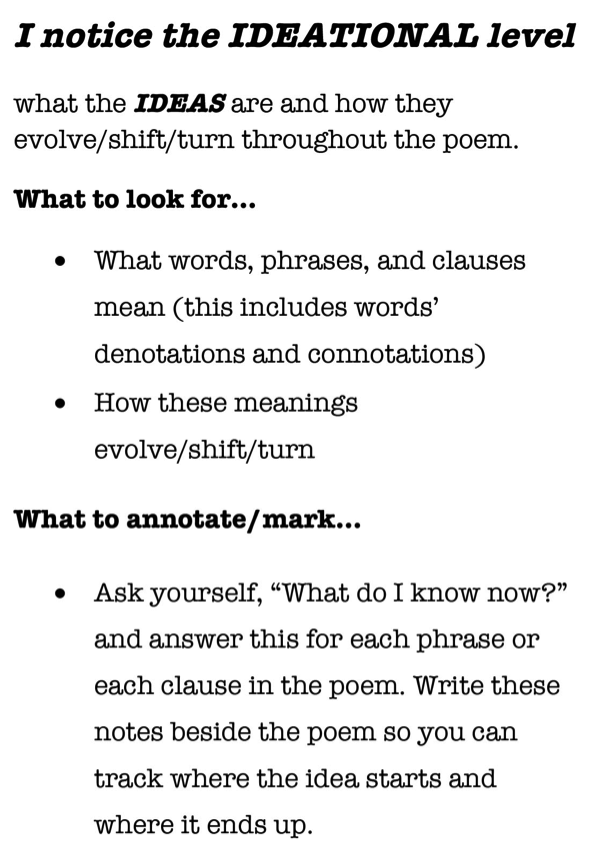
3.
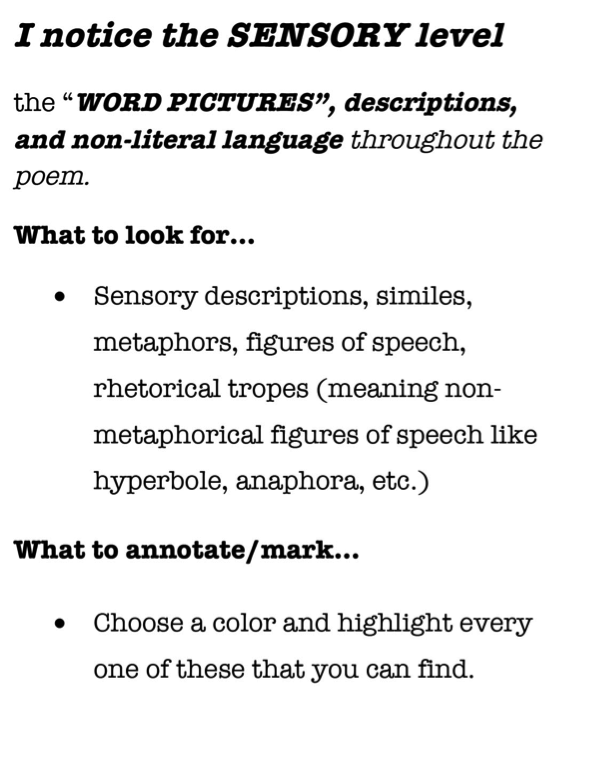
4.
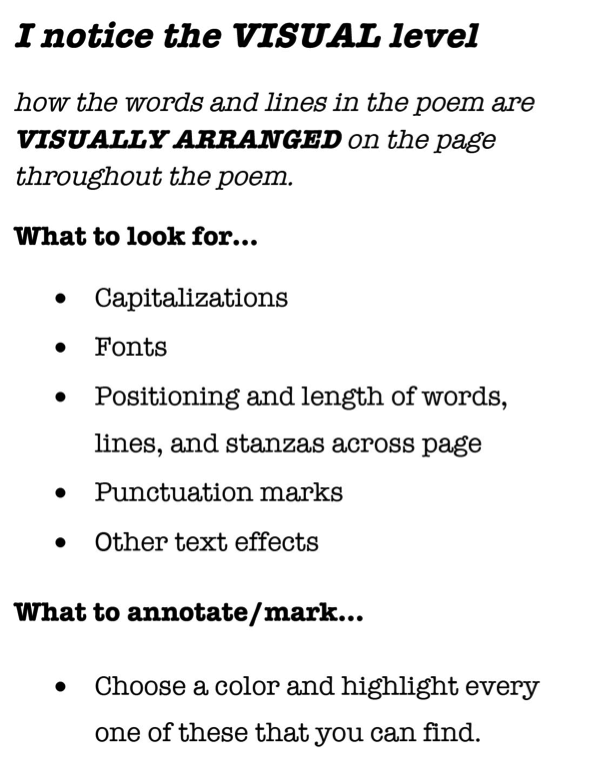
- Start by explaining to all students that all poetry/language art consists of these four levels and that students can access what Poetry is simply by noticing these levels and how they relate to one another. Make sure that you tell students that “noticing” simply means recognizing what is there. This is an adjustment for many students, focusing on an immersion in a poem’s language and mindfully noticing as much as possible, instead of searching for what the poem means. Tell students that they are not to make inferences, guess at meaning, or try to be “deep.” Make sure you insist to students that this is not about anything except for noticing the levels in poems.
- Divide students into four groups as appropriate; each group is responsible for noticing one level. Make sure students know they are NOT to try to be deep or infer any meaning at all at this point. They’re simply noticing as many instances of the levels of language as they can. Circulate around the room noting student progress. Ask students to show you when they finish, and ask them to look again if they’ve missed something. Some students may rush to meaning-making. Slow them down and ask them simply to identify what is in the poem. That’s it.
- Project the “I notice” Poem Level Meter (see Supplementary Documents) on the board. When all student groups have finished, ask one representative from each group to write what they’ve noticed in their levels on the board over the projected “I notice” sheet from the bottom up.
- A completed student sheet should look like this:
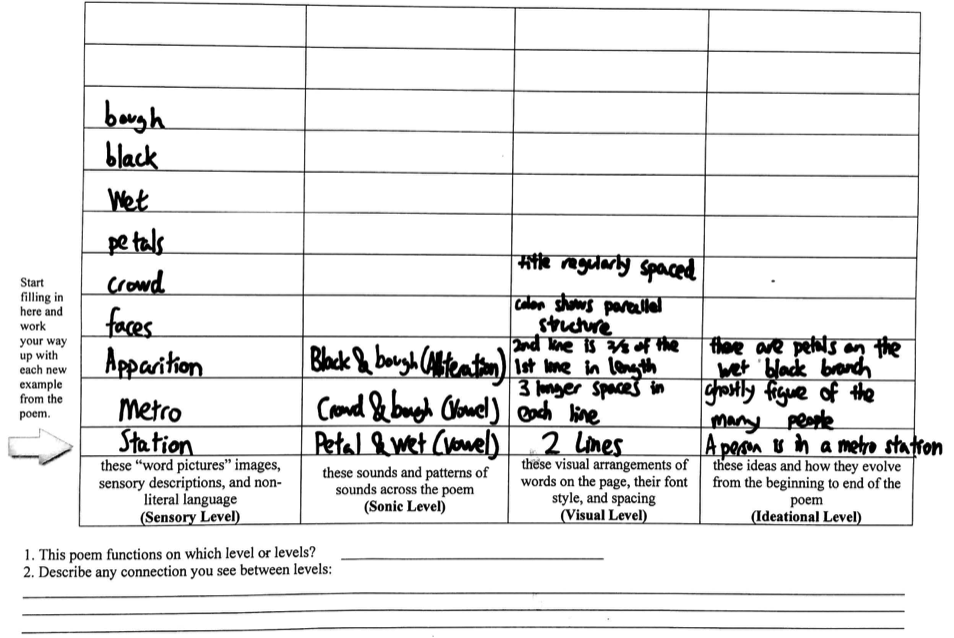
- Next, ask students, “Based on what you see, what is the dominant level in this poem?” This is the answer to question #1 on the Poem Level Meter. For this short poem, students should answer that the sensory/image-based level dominates in this poem. Tell students that this doesn’t mean that the other levels are less important; it just means that there are many images in the poem, and the poem functions predominantly on the “word-picture”/sensory level. However, remind students that that this level will almost certainly work in relationship with others.
- Ask students for answers to question #2, “What relationships do you see between two or more aspects/levels?” Take down any student notes on the board, drawing lines and making notes between different levels of the poem (see Poem Level Meter in Supplementary Documents).
- Discuss as a whole class. Allow students to write down notes from the discussion to demonstrate their listening skills. Collect as appropriate.
- Next, ask students to compose a reflection in answer to the question, “What do these relationships between the aspects/levels help you understand in the poem?” Ask students to justify their answers with the relationships on the board.
- Review the connections with the students, discussing what students know now that they didn’t know before. Draw their attention to how this new understanding happened – not by looking for meaning but by looking at the levels of language at play in the poem.
Objective: Students will use their newly learned noticing process to identify aspects/levels in multiple poems. They will practice this method until they feel comfortable with all four levels and discussing their relationships within poems (see student progress chart in supplementary documents). Students should repeat as necessary, at least four additional times in order to demonstrate they can recognize all four levels independently and then all four simultaneously.
Poems:
- “Let Evening Come” by Jane Kenyon
- “Invictus” by William Ernest Henley
- “Those Winter Sundays” by Robert Hayden
- “I Married You” by Linda Pastan
- Organize students at four tables of four, with each one focusing on a different aspect/level. You can choose four poems for sixteen students, five poems for twenty students, six poems for twenty-four students, and so on. If an odd number of students are in a class or a number not divisible by four, feel free to pair students up with one poem.
- Hand out copies of four contemporary poems to each of the students at each table: “Let Evening Come,” et. al. This means that one student at all tables will have the same poem as each of the other four tables. Let students choose their own poems from the four you place at the center of the table. All poems chosen should be approximately the same length and have different dominant aspects/levels.
- Each table should explore one level. Ask your students to read their poem once to themselves, and, as they do to identify instances of that one aspect or level only. Students can use their tablemates to help them identify all of the examples of their aspect/level in their respective poem, since their tablemates are specializing in seeing the one aspect/level in their own poems as well.
- Once students have marked up their poems in their table groups, then ask the students to reform their groups so that they are with the other people who have the same poem. Students should now be grouped with other students who had their poem, and there should be four student “experts” to help fill in one poem chart for the poem, much like what was modeled previously in class.
- Pass out the worksheet Poem Level Meter and ask student in their new groups to fill out the sheet with all of the evidence from their specific levels. It’s okay if some of the levels overlap, meaning a student could have the same word or phrase down in two or more areas. This will allow students to generate ideas about how these aspects/levels play off of one another in a poem, leading them to questions 1 and 2 as a group.
- After the group completes their Poem Level Meter, ask them to do the questions below the chart, agreeing on all relationships between levels as a group. Here’s an example of a Poem Level Meter (with three of the four levels) done for “Let Evening Come” by Jane Kenyon; notice that the answer to question #2 is an extension of the chart and its levels’ relationships. By not looking directly for meaning at the start, students focus on the aspects/levels of language at play, and their brainstorming allowed for meaning to organically emerge in question #2.
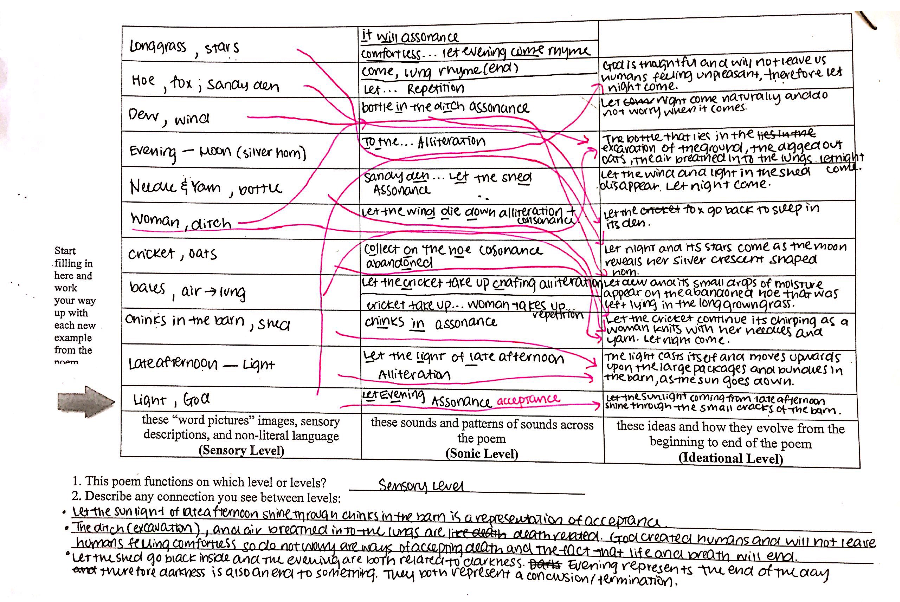
Poem Level Meter
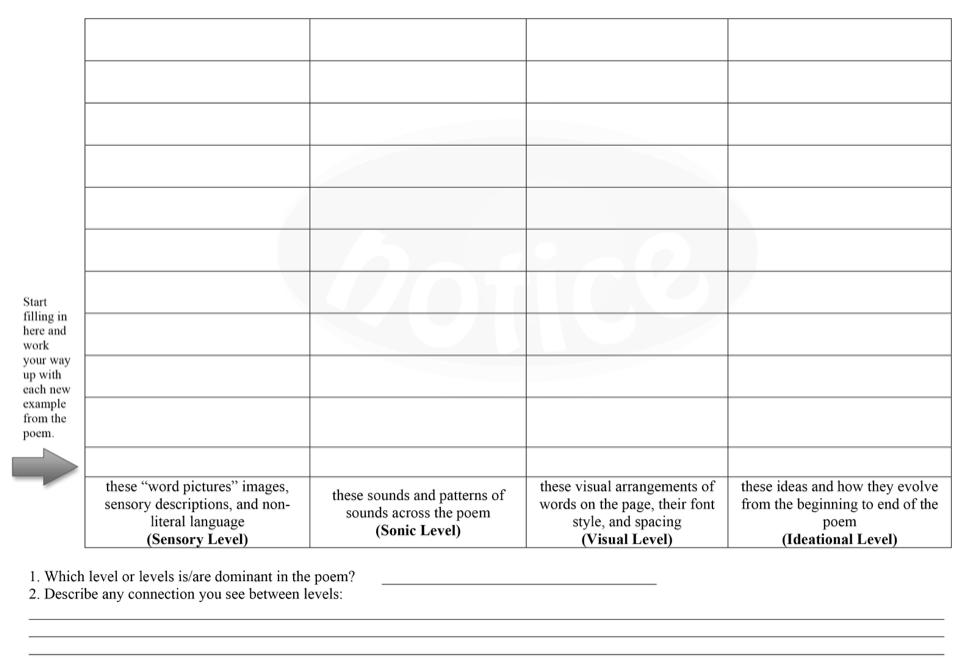
Student Progress Tracker
download student progress tracker
![]()
References
Theune, Michael. Structure & Surprise: Engaging Poetic Turns (2007). IWU Authors Bookshelf. Book 20.
Turco, Lewis Putnam. The Book of Forms: A Handbook of Poetics Including Odd and Invented Forms. Revised and Expanded Edition. Hanover and London: UP of New England, 2012.
